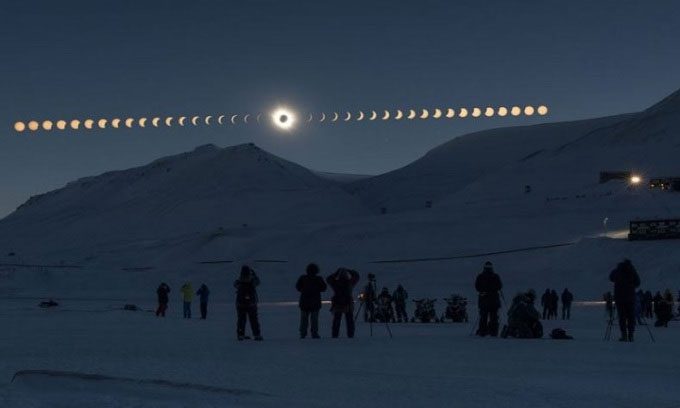The longest total solar eclipse ever recorded occurred over 2,700 years ago, lasting 7 minutes and 28 seconds, just a few seconds shy of the maximum duration.

Simulation of the phases of a total solar eclipse. (Photo: Earthsky).
On April 8, 2024, observers in areas of Mexico, the United States, and Canada will be able to witness a total solar eclipse, while the entire North America will at least experience a partial eclipse. The maximum duration of the total phase—when the Sun is completely obscured by the Moon—will be 4 minutes and 28 seconds, occurring near the village of Nazas in northwest Mexico. This duration is relatively long, but still far from the record for the longest total solar eclipse in history.
The longest total solar eclipse ever recorded was 7 minutes and 28 seconds long, taking place on June 15, 743 BC, over the Indian Ocean, off the coasts of Kenya and Somalia in Africa, according to NASA.
Mathematically, the longest possible total solar eclipse on Earth can last 7 minutes and 31 seconds, according to astronomer Jean Meeus. This event could occur within 5 degrees of the equator in July when the Sun is at its farthest from Earth and appears smaller in the sky, while the Moon is at its closest point to Earth.
No records of such a lengthy eclipse have occurred in at least the past few thousand years. However, in over 150 years, an event nearing this maximum could appear. Scientists have calculated future total solar eclipses. Accordingly, the eclipse in the Atlantic Ocean, off the coast of French Guiana on July 16, 2186, is expected to have a total phase lasting 7 minutes and 29 seconds.
“In the 2186 eclipse, the shadow of the Moon will appear above the center of the Earth. The Moon will appear very large because it is relatively close, and the Sun will look very small because it is far away. All these factors combined will make the total phase of the 2186 eclipse exceptionally long,” said eclipse expert Dan McGlaun.
Although the longest total solar eclipse in history occurred thousands of years ago and the next longer eclipse will not happen for more than 100 years, observers can “cheat” if they have a supersonic plane. On June 30, 1973, seven scientists aboard the supersonic Concorde 001 flew at Mach 2 (twice the speed of sound) to extend their viewing time of the total solar eclipse from 7 minutes and 4 seconds to an astonishing 74 minutes.


















































